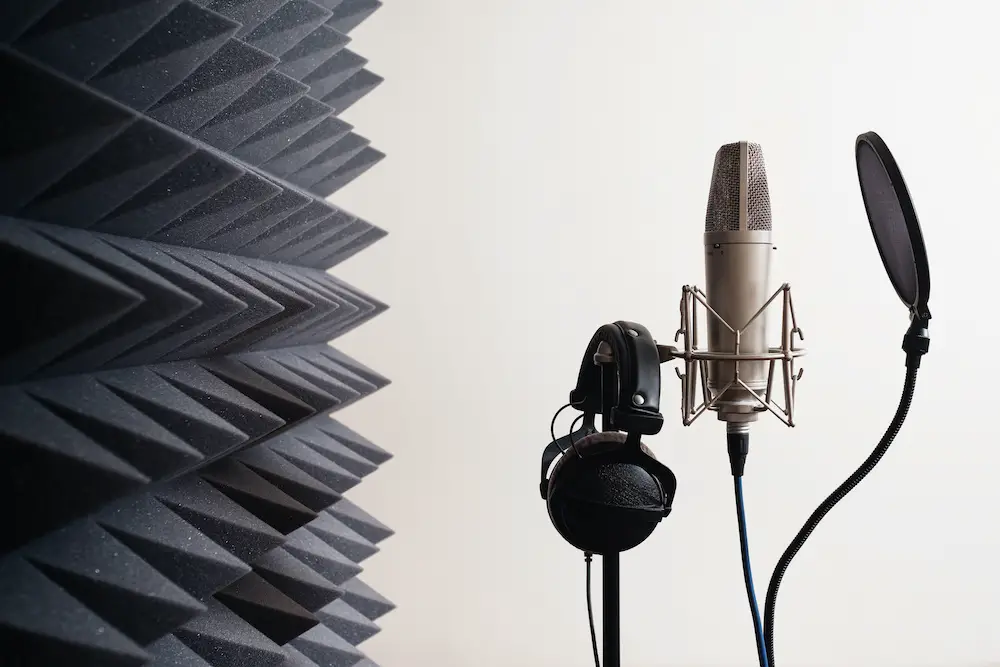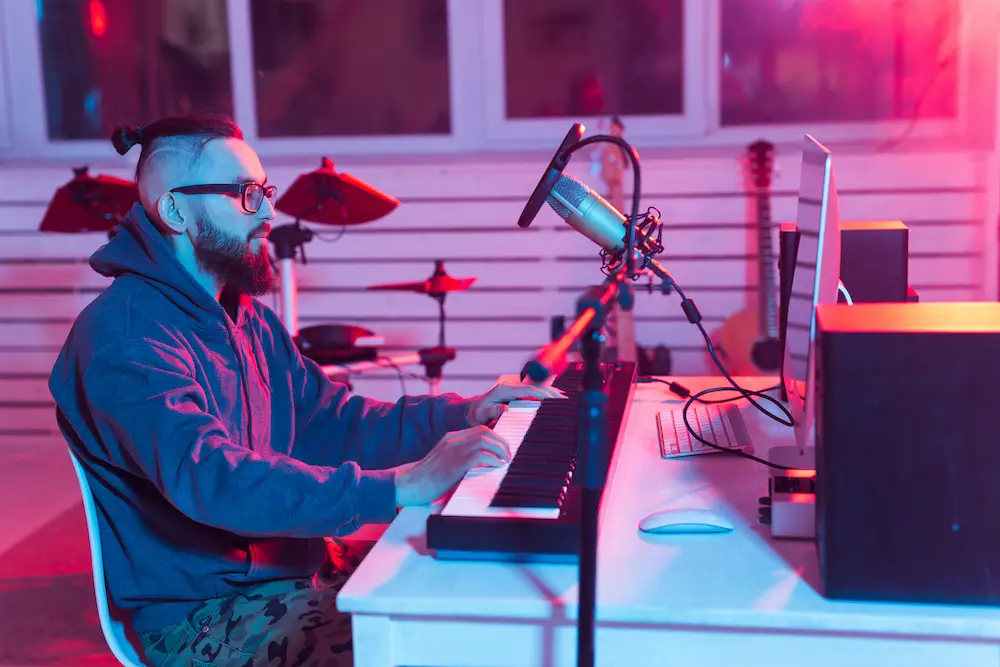How to Set up a Home Recording Studio
by vocals-in-tunepublished on
You may wonder how to set up a home recording studio. In this article, we'll take a look at what you need to do just that.
In today’s world, anyone can record music by sitting at their home. All you need is a laptop and a microphone, but why stop there?
You have options: build a studio with all the gears at once and upgrade your set-up gradually while growing as a musician. Before learning about how to set up a home recording studio and investing in one, though, you need to make sure you have the skills. You can’t buy skills, but you can definitely polish them.
How to Set up a Home Recording Studio
There are two main steps in setting up your home recording studio: setting up your equipment and room.
Equipment Set-Up
If you are wondering where to start, you need the right recording gear for your home studio.
So, how can you set up one with all the required equipment without costing a fortune?
Well, it is easier than you think!
1. Computer
First up, you need to buy a computer. All of your work will be done on a computer; hence, it needs to be up-to-date. You can either get a Mac or Windows PC; it doesn’t matter. There's no need to buy the latest Mac Pro since it will cost you an arm and a leg, plus Macbook Retina won’t do the job either since it lacks many features. Any PC with a good processor having at least 4 GB RAM can allow you to record audio tracks.
The only thing that matters is the specs, something fast, large storage, and the capability of processing the audio recording.
2. Digital Audio Workstation
The next thing you will need is software to record and edit your audio. Gone are the days when you need a DAW hardware to edit your sounds, as nowadays, any good DAW software will do the job for you. No matter if you are at an initial stage or need to give the final touch to your song, you will need software at every point. Digital Audio Workstation (DAW) is a software program, which allows you to record, edit, and be creative with your digital audio.
There are several DAW software available in the market, including Apple’s Logic and Garage Band.
Some of them are quite expensive, so before purchasing any software, try a free demo and buy whichever suits you the best.
3. Audio Interface
As you are setting up a home studio to record music professionally, the computer’s microphone will not work well. You will need one or more microphones to record the professional level of audio, be it your vocals or a guitar. That is why you need to buy an audio interface to connect your microphone and other instruments to your computer.
An audio interface will improve the sound quality of your computer when you record or listen to the recorded audio. The interface has a few USB ports where you can connect your devices. Since you have a home studio, you won’t need so many inputs, so you can buy an interface with lesser inputs.
4. Microphone
One of the essential items of your home studio is a microphone since you will record either your vocals or any other acoustic instrument. Now you need to decide which microphone will be best for your studio. There are several types of microphones available in the market, depending on the kind of sound you want to record. Also, you need a microphone with a large-diaphragm if you want to record songs. Since you are just starting out, you can buy one or two microphones and then slowly upgrade.
5. Studio Monitors
A pair of speakers will help you listen to what kind of music you are producing. Studio monitors are different from typical speakers present in your living room; they sound more neutral so you can mix and produce a better quality of music.
Unlike other speakers, studio monitors give a flat sound so that every frequency can sound normal. Studio monitors are not a mandatory purchase, but they will help you mix the sound perfectly, so it's best to buy them. However, studio monitors often come at a high price. But if you research more, you will find a pair of studio monitors that will fall in your budget.
6. Headphones
You will need headphones to listen to the audio if you want to record vocals at the start. If you don’t have a large budget, headphones can be an excellent alternative to studio monitors. Also, if you have any loud sound restriction in your house, headphones will allow you to listen to the sound without creating any noise.

Not every kind of headphone can serve the purpose; there are different types of headphones for the home studio. You will find two kinds of headphones, especially for listening and mixing the recorded audio. One is closed-back, and the other is open-back headphones for the studio. At the start, you should buy closed-back headphones since you can monitor sound while recording and mixing the audio after recording.
7. Microphone Stand
Many beginners don’t understand the importance of a good microphone stand. A light, flimsy stand will make your life difficult since it will keep falling while you are recording. We suggest you consider quality when buying a stand.
A microphone stand is a one-time investment, and it will go a long way if you buy a high-quality stand. You can find a solid stand within your budget.
Lastly, a stand with three legs is more reliable than a single leg, so go for a solid three-leg stand for your home studio.
8. Pop Filters
Have you ever noticed a filter on the microphone and wondered why it is there?
Well, the filter that covers a microphone is a pop filter, and it is mainly used to filter any unpleasant noise. While most beginners skip filters, we would suggest you purchase them. Not only will your recorded audio sound more professional, but it will also come at a low price.
Setting up the Room
Now that you have sorted the recording gear, it is time to decide how to set up a home recording studio in a room. A well-designed room can have a significant impact on your music. Since you will only hear your voice in the studio, all the mixes will sound better once you organize your room.
1. Acoustic Treatment
If you have options, choose a large room with high ceilings and no window for your studio, but if you have no choice and only get one spare room, you need to do a bit of acoustic treatment. If you aren’t familiar with acoustic treatment, it controls all the sound reflection in the room for better sound recordings.
You can add three acoustic elements in your room for controlling sound reflection, but the best one to buy is bass traps. Bass traps are placed on all four corners of the room where they absorb low sound frequencies.
2. Place Your Studio Monitor
You can change the position of other devices in the room, but once you place studio monitors, you shouldn’t remove them from their position. While there is a complete science in the placement of monitors, we will not get into much depth. The best position is to place the monitor at an equal distance from both walls. In this way, a natural balance of sound will exist, and you will properly hear the mixes without any nuisance.
3. Set up Your Studio Table and Chair
It is time to set up a table and a chair in your newly designed home studio. There is no need to buy a new table if you already have one; you can save money on this part.
Place your computer, your microphone stand, and the audio interface on the table. You can place all the extra cables under the table, so they don't create a mess.
Make sure the chair you are placing in the studio is comfortable since you will spend hours in the studio mixing music. If you still have the budget, you can invest in a decent studio chair so that your back won’t hurt.
Conclusion
Nothing is more satisfying than hearing your recordings playing in your new home studio.
Building a home studio is a daunting and expensive task, so think wisely before investing your money in equipment and designing the room. Hence, before setting up a studio, you should learn how to sing and compose music professionally.
Our guide will help you in all the aspects of setting up a home studio. The only thing you need to do now is to follow the guide precisely and start recording! Let your creative vision come out and follow your dream.
